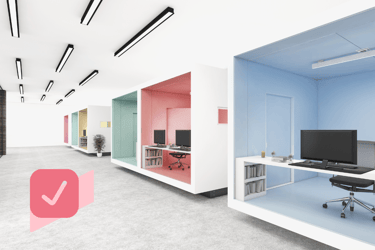Meeting Management and Space Allocation in the Modern Workplace
August 20, 2019 CXAI Team
How a Mobile App Enhances Teamwork and Collaboration On-The-Go
Meetings have always been an integral part of the workplace. They're part of the routine of being at the office. Nothing exciting there, right? In fact, we're so used to meetings that we overlook just how important they are.
Meetings Are a Big Deal
If done right, meetings can increase motivation. Consider that 39% of employees feel under-appreciated at work, with 77% reporting that they would work harder if they felt better recognized. In what context is this recognition supposed to take place? You've guessed it: meetings. The face-to-face between a manager and employee is a special opportunity to increase engagement, but clearly, not many bosses are taking full advantage. Meanwhile, keep in mind that disengaged workers cost the economy $300 billion or more per year.
Indeed, as most of us can attest, meetings are largely inefficient. For instance, using a detailed agenda can decrease the amount of meeting time up to 80%, yet no more than 37% of meetings in the US use agendas. The cost here is hefty too: unproductive meetings waste more than $37 billion per year. Clearly, there's plenty of incentives to turn these trends around.
So why is this happening? In short, the old way of doing things in the workplace is stagnant. Teams have standing appointments for lengthy meetings each week, instead of short get togethers on an as-needed basis with very clear goals. In an age of remote work and employees with flexible hours, it's more challenging than ever to coordinate schedules, and more important than ever for everyone to be on the same page across a distributed workforce.
Now, the modern workplace is changing to achieve more efficiency in this arena. Let's dive into some new capabilities and practices:

On-the-go Access
Thanks to new mobile workplace hubs, employees get instant access to a meetings and calendar system, anywhere, anytime. This is important because it encourages ongoing collaboration, before, during and even after the meeting itself. Everyone has access to the system, can view relevant documents and communicate quickly across departments.
Mobile Meeting Scheduling
In the evolved office, meeting spaces can be scheduled from a mobile touchpoint. This is more efficient, as employees can use room booking systems quickly search in one place to find availability and book the room they need in only seconds. The underlying idea here is that a meeting itself (especially if done well) is work. It shouldn't be an additional headache to make it happen.
Powerful Filters
When you stop and think about it, there's a lot that goes into planning an effective meeting. The space itself is an important consideration. Is the room big enough? Does the space come with the equipment needed for a particular presentation? How far does each attendee have to travel?
That's why the newest corporate campuses offer the option to not only schedule meetings on-the-go, but make selections based on time, proximity, number of attendees, amenities, and more. Now that's efficient!
Booking Desks
Beyond conference rooms, the modern employee often needs to book a desk. This is due to how often people travel to different branch offices and the increase in remote workers or employees who set their own schedules. After all, 68% of global employees work from home at least once per month. These individuals want to ensure they have a space that suits their needs so they can enjoy being in the office.
As a result of these new developments, desk booking software is practically essential these days, as spaces themselves are being reimagined.
The New and Improved Workplace
This renewed focus on increasing efficiency and ultimately helping the bottom line by investing in better employee experiences - such as streamlined meetings and easy space booking - has led full circle, from abstract concepts back to the brick and mortar physical space. Why?
No matter how impressive an employee experience platform, it has to truly connect with the real world structure in which it's used. The digital and physical worlds must be merged, so that users can engage in both simultaneously for a connected workplace experience.
To that end, in tandem with the adoption of mobile hubs, corporate campus are shaking things up by designing more modular and dynamic spaces. By using data on employee behavior and preferences from a digital system, operations teams can quickly adapt the office itself to optimize for productivity.
The modern workplace is truly going to be purpose-built with employees in mind, which is pretty exciting news! Who knows, in the near future, meetings might be something we all dread a little less.

.png)

.png)



-1.png?width=450&height=250&name=Smart%20Campus%20App%20(1)-1.png)


